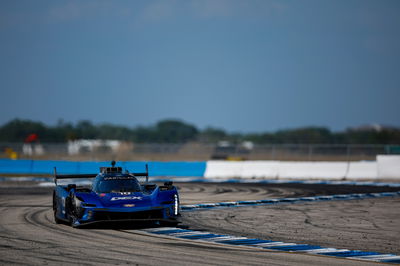Zytek to benefit from advanced gearshift system.
Motorsport engineering specialist Zytek has developed a new gearshift system for motor racing applications, and is aiming to use it to take the fight to pre-race favourites Audi at this weekend's Le Mans 24 Hours.
The Zytek EGS - standing for electrically-assisted gearshift system - is lighter and simpler than the alternative hydraulic or pneumatic systems, while its all-electric operation offers high reliability, straightforward integration and improved gearbox life.
Motorsport engineering specialist Zytek has developed a new gearshift system for motor racing applications, and is aiming to use it to take the fight to pre-race favourites Audi at this weekend's Le Mans 24 Hours.
The Zytek EGS - standing for electrically-assisted gearshift system - is lighter and simpler than the alternative hydraulic or pneumatic systems, while its all-electric operation offers high reliability, straightforward integration and improved gearbox life.
The system has already enjoyed a successful public debut on the 'works' Zytek 04S that worried the leading Audi UK Team Veloqx R8s in the Monza 1000km last month, and has been deemed reliable enough to continue on the car at Le Mans.
"Electric power is the ideal solution to the problem of fast, reliable gearshifts in race conditions," explained Aidan Gregory, chief engineer at Zytek Systems British base, "Until now, the need for sophisticated energy management and delivery has proved a barrier to implementation, but we've been able to apply knowledge gained from our electric vehicle programmes to make a robust, flexible and easily integrated solution."
Zytek 'factory' drivers David Brabham and Andy Wallace will hopefully feel the benefit of the EGS system, which is reputed to produce individual gearshifts in less than 40ms - and up to four downshifts in less than a second.
The precise movement of the electric actuators also means that there is very little wear on the gear selector mechanism and dog rings, extending gearbox life and improving reliability and shifting accuracy. The fully-electric approach removes the need for a separate hydraulic or pneumatic system, reducing vehicle mass and complexity. Once fitted, the system is essentially maintenance-free and there is no potential for leakage of air or hydraulic fluid.
The EGS weighs approximately 3kg and operates using fast-acting solenoids. A double-acting solenoid actuates the gearshift - although two single actuators can be also be used, if preferred or made necessary by installation constraints - while a single-acting solenoid provides a throttle 'blip' function. The driver operates the system using steering wheel-mounted shift paddles, with separate push-button switches to select reverse and neutral. Both upshifts and downshifts are effected without the need to operate the clutch, which is only required for launch or for the selection of reverse gear or neutral.
The gearshift requires extremely precise control and state-of-the art energy management, and Zytek has made use of its long background in control electronics and software, and the electromechanical design expertise of its electric vehicles division, to engineer a system which can operate reliably in the most demanding race conditions without excessive power consumption. The EGS control unit includes built-in energy storage, which accumulates electrical energy from the vehicle alternator between gearshifts and delivers high power extremely rapidly for a fast shifting action. All system components, together with the control and calibration software, have been developed in-house by Zytek.
The control system interfaces directly with both Zytek and third-party engine controllers, either using hard wiring or via a CAN interface. The unit also interfaces with steering wheel instrumentation. Rapid system calibration is made possible with the support of built-in data logging and Zytek's highly-regarded calibration and data analysis tools, which are run on a notebook PC connected to the control unit.
Zytek sees most race series - and, in particular, one-make series, where the simple installation and low maintenance requirements are especially important - as potential outlets for the new system. It is currently in negotiation with a number of series organisers, and is on the look-out for teams and individuals interested in using the technology.










